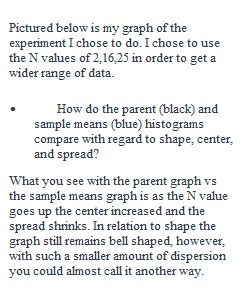


Q Evaluate In this activity, we will draw thousands of simulated samples from a population and discuss the distribution of the resulting sample means. Doing so will build a foundation for understanding the concepts underlying inferential statistics and will prepare us for the work in Part II of this module. To view a video of the following directions, click here (Links to an external site.) [Video file] [4 min 19 sec] (Plain Text File). Note: The course appearance has changed somewhat since this video was created, but the information provided is up-to-date. • We will simulate Sampling Distributions at OnlineStatBook.com (Links to an external site.). Click the “Begin” button when it appears at the left of the screen. You will see a pop-up that looks like this histogram example 1. • On the Sampling Distributions pop-up, you can change the shape and parameters of the distribution by clicking and dragging your mouse over the histogram or by selecting from the options at the right, for example: • To see how this simulation works, click the “Animate” button below the word “Sample” on the webpage. You will see 5 black blocks representing data values drop onto the scale, like a dot plot, and the mean of those 5 values will appear as a blue block on the third axis. Click “Animate” several more times to see the sample means begin to accumulate and form their own histogram, perhaps like this histogram example 2. In order to make the simulation go faster, we can skip the animation of individual samples and collect thousands of samples at once. To obtain the graph of histogram example 3, click to clear the lower 3 graphs, and then select 10,000 samples of size n=5 from the right-skewed parent population. The blue histogram shows the distribution of the sample means. Now, it is your turn to play and discuss. Follow the directions on the Sampling Distributions Worksheet Download Sampling Distributions Worksheet[DOCX file size 21 KB]. Once you have completed the worksheet: • Reflect on what you have observed: o How do the parent (black) and sample means (blue) histograms compare with regard to shape, center, and spread? o Does the sample size, n, affect the results? If so, how? • Post your reflections in the Sampling Distributions discussion. Attach your completed worksheet. • Then, go back to the discussion to review what your classmates have posted. Can you find a general pattern or theme? Post your reactions. To earn the maximum number of points for this discussion you must: • Post your reflections and attach your completed worksheet. • Participate in a discussion in a substantial manner with at least two of your classmates, as described above. ________________________________________ Your initial post is due by Thursday at 11:59 PM ET. Your responses are due by Sunday at 11:59 PM ET. Consult the Discussion Posting Guide for information about writing your discussion posts. It is recommended that you write your post in a document first. Check your work and correct any spelling or grammatical errors. When you are ready to make your initial post, click on "Reply." Then copy/paste the text into the message field, and click “Post Reply.” This is a “post first” discussion forum. You must submit your initial post before you can view other students’ posts. To respond to a peer, click “Reply” beneath her or his post and continue as with an initial post. ________________________________________ Evaluation This discussion will be graded using the discussion board rubric. Please review this rubric, located on the Rubrics page within the Course Introduction module of the course, prior to beginning your work to ensure your participation meets the criteria in place for this discussion. All discussions combined are worth 20% of your final course grade.
View Related Questions